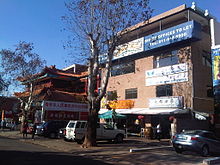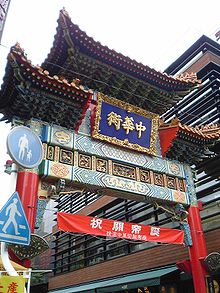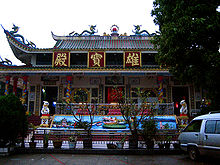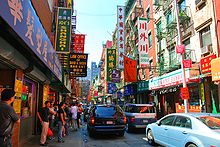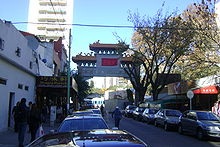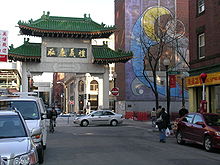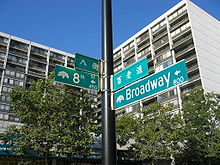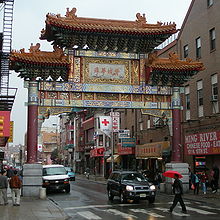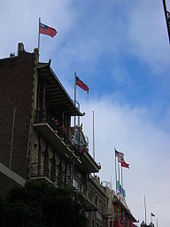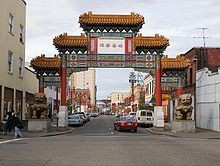- Chinatown
-
This article is about the type of ethnic enclave generally. For other uses, see Chinatown (disambiguation).
 Chinatown, San Francisco, the oldest and one of the largest Chinatowns in North America.
Chinatown, San Francisco, the oldest and one of the largest Chinatowns in North America.
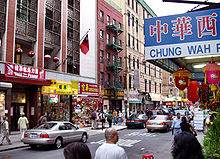 Manhattan's Chinatown, one of the largest concentrations of Chinese people in the Western Hemisphere.
Manhattan's Chinatown, one of the largest concentrations of Chinese people in the Western Hemisphere.
A Chinatown is an ethnic enclave of overseas Chinese people. Chinatowns exist throughout the world, including East Asia, Southeast Asia, the Americas, Australasia, and Europe. Binondo's Chinatown located in Manila, Philippines is the oldest Chinatown, established in 1594.[1] Many Chinatowns are considered significant centers of commerce and tourism,[citation needed] while some also serve, to varying degrees, as centers of multiculturalism.[citation needed]
While some Chinatowns are focused on commercial tourism, others are actual living and working communities; many are in fact a synergetic synthesis of both. Chinatowns can range from slum ghettos to modern sites of up-to-date development.[citation needed] In some, recent investments have revitalized rundown and blighted areas and turned them into centers of buzzing economic and social activity.[citation needed] In certain cases, this has led to gentrification and a reduction in the specifically Chinese character of the neighborhoods.[citation needed]
Several Asian Chinatowns, although not yet called by that name, have a long history. Those in Nagasaki, Japan[2], Binondo in Manila, and Hoi An in central Vietnam[3] all existed in 1600. Glodok, the Chinese quarter of Jakarta, dates to 1740.[4] The Chinatown centered on Yaowarat Road in Bangkok, Thailand, was founded at the same time as the city itself, in 1782.[5] The Chinatown in San Francisco is the oldest and one of the largest Chinatowns in North America. Other cities in North America where Chinatowns were founded in the mid-nineteenth century include almost every major settlement along the West Coast from San Diego to Victoria. By the second half of the nineteenth century, bustling Chinatowns were also established in Vancouver, New York City, Los Angeles, Toronto, Boston, Philadelphia, Chicago, Detroit, and Montreal.[citation needed] The discovery of gold in Australia caused the establishment of relatively small Chinatowns in cities there, and similar migrations of Chinese resulted in tiny settlements termed "Chinatowns" being established in New Zealand and even South Africa.[citation needed] European Chinatowns, such as those in Germany, the Netherlands, and the United Kingdom, are for the most part smaller and of more recent history than their North American counterparts. Newer Chinatowns, such as Chinatown, Las Vegas in 1995, Dubai and Santo Domingo have also received official recognition recently.
Contents
- 1 History of the earliest Chinatowns by region
- 2 Features
- 3 Names for Chinatowns
- 4 See also
- 5 References
- 6 Further reading
- 7 External links
History of the earliest Chinatowns by region
See also: List of ChinatownsTrading centres populated predominantly by Chinese men and their native spouses had long existed throughout Southeast Asia. Emigration to other parts of the world from China accelerated in the 1860s with the enactment of the Treaty of Peking, which opened the border for free movement. Early emigrants came primarily from the coastal provinces of Guangdong and Fujian (Fukien, Hokkien) – where Cantonese, Hakka, and Chaozhou (Teochew, Chiu Chow) are largely spoken—in southeastern China. Initially, the Qing government of China was unconcerned by the emigration of this population as they were likely considered socially undesirable and "traitorous" to China.[citation needed] Trading and moneymaking was considered vulgar and consequently frowned upon in Confucian China, in which Chinese migrants were intending to earn wages as sojourners.[citation needed] However, the Chinese were not strictly united as a group but were divided along sub-ethnic/linguistic lines and friction between those of Cantonese (Punti) and Hakka stocks were common occurrences.[citation needed] Generally, there were also mild but recognisable sub-divisions based on Chinese clans/surnames.
Taishanese people and Cantonese settled in the first North America, Australian, and Latin American Chinatowns.[citation needed] Most of them were brought as contract coolies to build the railroad, but many had come originally in pursuit of gold. As a group, the Cantonese are linguistically and ethnically distinct from other groups in China with migrants especially coming mostly from the Siyi and Sanyi regions (with various variations of spoken Cantonese) of Guangdong; Cantonese remained the dominant language and heritage of many Chinatowns in Western countries until the 1970s.[citation needed] Due to laws in some countries barring the importation of Chinese wives (for fear of the perceived Yellow Peril), some Chinatowns emerged as bachelor's societies where males dominated and the male-to-female ratio population was generally skewed.[citation needed] In Latin America, many Cantonese-speaking migrants arrived as indentured labourers particularly in Peru (to work in the deadly guano fields) and Cuba (to labor in sugar plantations) giving those countries substantial Chinatowns.[citation needed]
The Hokkien and Chaozhou (both groups speaking the Minnan sub-group of Chinese dialects), along with Cantonese are the dominant group in Southeast Asian Chinatowns.[citation needed] Chinese migrants also pioneered some major Southeast Asian cities, such as Kuala Lumpur, Malaysia and hence Chinese influence is felt there. The Hakka groups established Chinatowns in Africa (particularly Mauritius),[citation needed] Latin America, and the Caribbean. Northern Chinese settled in Korea in the 1940s.[citation needed]
In Europe, early Chinese were generally seamen who jumped ship and began to provide services for other Chinese mariners[citation needed]. In the nineteenth century and early twentieth century, the United Kingdom treated China as part of its unofficial Empire employing Chinese in its merchant marine in significant numbers. Consequently, from the 1890s onwards, significant Chinese communities grew up in London and Liverpool – the main ports for the China trade. However, these communities were a mixture of Chinese men, their British wives and their Eurasian children. Moreover, they were generally inhabited by those Chinese catering for Chinese seamen. The majority spread throughout these cities usually operating laundries at this time.
France received a large settlement of Chinese immigrant laborers, mostly from the city of Wenzhou, Zhejiang province of China (to this day, France continues to attract many Chinese immigrants from this particular province; Paris' newest Chinatown in Belleville is heavily influenced by such immigrants).[citation needed] Chinatowns also are found in the Indian city of Kolkata (See article) (once Hakka influenced) and formerly in Mumbai (See article).
By the late 1970s, the Vietnam War also played a significant part in the development and redevelopment of various Chinatowns in developed Western countries. As a result, many Chinatowns have become pan-Asian business districts and residential neighborhoods. By contrast, most Chinatowns in the past were solely inhabited by Chinese from southeastern China.
Historic Chinatowns such as San Francisco has had a significant influence on the perception of Chinatowns in western countries. Although, in reality, it and other North American Chinatowns fall outside the tradition of Chinese settlement in having significant numbers of Chinese women.
Africa
Main article: Chinatowns in AfricaThere are three noteworthy Chinatowns in Africa located in the coastal African nations of Madagascar, Mauritius, and South Africa. South Africa has the largest Chinatown and the largest Chinese population of any African country and remains a popular destination for Chinese immigrants coming to Africa. The Chinatown on Derrick Avenue in Cyrildene, Johannesburg is South Africa's largest Chinatown.
Asia
Main article: Chinatowns in AsiaChinatowns in Asia are widespread with a large concentration of overseas Chinese in East Asia and Southeast Asia and ethnic Chinese whose ancestors came from southern China – particularly the provinces of Guangdong, Fujian, and Hainan – and settled in countries such as Brunei, Cambodia, Indonesia, Laos, Malaysia, Myanmar, Singapore, the Philippines, Thailand, and Vietnam centuries ago—starting as early as the Tang Dynasty, but mostly notably in the 17th through the 19th centuries (during the reign of the Qing Dynasty), and well into the 20th century.
- Chinatown, Gachsaran (Mahale chiniha) (Iran)
- Chinatown, Singapore (Singapore)
- Chinatown, Kuala Lumpur (Petaling Street) (Malaysia)
- Chinatown, Bangkok (Yaowarat Road) (Thailand)
- Chinatown, Manila (Binondo) (Philippines)(oldest outside Chinese territory established 1521)
- Chinatown, Davao City (Philippines)
- Chinatown, Nagasaki (Shinchimachi) (Japan)
- Chinatown, Ho Chi Minh City (Cholon) (Vietnam)
- Chinatown, Jakarta (Glodok) (Indonesia)
- Chinatown, Kolkata (Tangra) (India)
- Chinatown, Karachi (Pakistan)
- Chinatown, Yokohama (Japan)
- Chinatown, Kobe (Japan)
- Chinatown, Incheon (South Korea)
- Chinatown, Mumbai (India)
Australia
Sydney
Main article: Chinatown, SydneySydney's main Chinatown centres around Sussex St in the Sydney CBD, Sydney. It stretches from Central Station in the east to Darling Harbour in the west. It is Australia's largest Chinatown.
Melbourne
Main article: Chinatown, MelbourneThe Chinatown of Melbourne in Australia lies within the Melbourne Central Business District and centers around the eastern end of Little Bourke St. It extends between the corners of Swanston and Exhibition Streets.
Melbourne's Chinatown originated during the Victorian gold rush in 1851 when Chinese prospectors joined the rush in search of gold. It is notable as the oldest Chinatown in Australia. It is also the second-longest continuously running Chinese community outside of Asia, only because the 1906 San Francisco earthquake all but destroyed the chinatown in San Francisco in California.[6][7][8]
Adelaide
Main article: Chinatown, Adelaidethe Chinatown of Adelaide in Australia was originally built in the 190's and as renovated in the 1980's. It is located near Adelaide Central Market and Adelaide Bus Station. It is the smallest Chinatown in Australia.
United States
Main article: Chinatowns in Canada and the United StatesSan Francisco
Main article: Chinatown, San FranciscoA Pacific port city, San Francisco has the oldest and longest continuous running Chinatown in the Western Hemisphere.[6][7][8] It originated circa 1848 and served as a gateway for incoming immigrants who arrived during the California gold rush and the construction of the North American transcontinental railroads. Chinatown was later reconceptualized as a tourist attraction in the 1910s.[citation needed] Contrary to the beliefs of some, San Francisco's Chinatown was nearly, but not completely destroyed by the 1906 earthquake, nor did all of its inhabitants re-locate elsewhere. Looming large were proposals by real estate speculators and politicians to expand the Financial District's influence into the area, and moving the Chinese community to the southern part of the city. In response, many of Chinatown's residents and landlords stayed behind to stake their neighborhood's claim, sleeping out in the open and makeshift tents. Numerous businesses and housing based in brick buildings survived with moderate damage and continued functioning, if only in a limited capacity. In just 2 short years after the earthquake, the landmark Sing Fat and Sing Chong buildings were completed as a statement of the Chinese community's resolve to remain in the area. As a result of this action, Chinatown remains the longest, continuous running Chinese community outside of Asia.[6][7][8] Still a community of predominantly Taishanese-speaking inhabitants, San Francisco's Chinatown became one of the most important Chinese centers in the United States.[9][10]
New York City
Main articles: Chinatown, Manhattan; Chinatown, Flushing; and Chinatown, Brooklyn
The New York City Metropolitan Area contains the largest ethnic Chinese population outside of Asia, enumerating 665,714 individuals as of the 2009 American Community Survey Census statistical data,[11] comprising at least 7 Chinatowns (including 6 in New York City proper[12]). Chinese Americans, as a whole, have had a (relatively) long tenure in New York City. The first Chinese immigrants came to Lower Manhattan around 1870, looking for the "gold" America had to offer.[13] By 1880, the enclave around Five Points was estimated to have from 200 to as many as 1,100 members.[13] However, the Chinese Exclusion Act, which went into effect in 1882, caused an abrupt decline in the number of Chinese who immigrated to New York and the rest of the United States.[13] Later, in 1943, the Chinese were given a small quota, and the community's population gradually increased until 1968, when the quota was lifted and the Chinese American population skyrocketed.[13] In the past few years, the Cantonese dialect that has dominated Chinatown for decades is being rapidly swept aside by Mandarin Chinese, the national language of China and the lingua franca of most of the latest Chinese immigrants.[14]
Additional Chinatowns
- Chinatown, Boston
- Chinatown, Philadelphia
- Chinatown, Washington, D.C.
- Chinatown, Los Angeles
- Chinatown, Chicago
- Chinatown, Honolulu
- Chinatown, Detroit
- Chinatown, Houston
- International District, Seattle
- Chinatown, Portland
Canada
Vancouver
Main article: Chinatown, VancouverVancouver's Chinatown is the largest in Canada.[15] Dating back to the late 19th century, the main center of the older Chinatown is Pender and Main Street in downtown Vancouver, which is also, along with Victoria's Chinatown, one of the oldest surviving Chinatowns in North America, and has been the setting for a variety of modern Chinese Canadian culture and literature. Vancouver's Chinatown contains numerous galleries, shops, restaurants, and markets, in addition to the Chinese Cultural Centre and the Dr. Sun Yat Sen Classical Chinese Garden and park; the garden is the first and one of the largest Ming era-style Chinese gardens outside China.
Although only one neighbourhood is designated as Chinatown in modern Greater Vancouver, the high proportion of Chinese people living in the region (the highest in North America) has created many commercial and residential areas that while Chinese-dominated are not called "Chinatown", as in Greater Vancouver that refers only to the historic Chinatown in the city core. There is an abundance of Chinese and Asian malls in the region, with the highest concentration in the Golden Village district of Richmond.
Toronto
Main article: Chinatown, TorontoChinatown, Toronto is an ethnic enclave in Downtown Toronto, Ontario, Canada, with a high concentration of ethnic Chinese residents and businesses extending along Dundas Street West and Spadina Avenue. First developed in the late 19th century, it is now one of the largest Chinatowns in North America and one of several major Chinese-Canadian communities in the Greater Toronto Area.
Additional Chinatowns
- Chinatown, Calgary
- Chinatown, Edmonton
- Chinatown, Montreal
- Chinatown, Ottawa
- Chinatown, Victoria
- Chinatown, Winnipeg
Latin America
Main article: Chinatowns in Latin America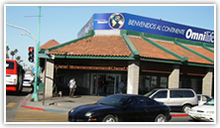 Chinese shopping center in Mexicali
Chinese shopping center in Mexicali
Chinatowns in Latin America developed with the rise of Chinese immigration in the 19th century to various countries in Latin America as contract laborers in agricultural and fishing industries. Most came from Guangdong Province. Since the 1970s, the new arrivals have typically hailed from Hong Kong, Macau, and Taiwan. Latin American Chinatowns may include the descendants of original migrants – often of mixed Chinese and Latino parentage – and more recent immigrants from East Asia. Most Asian Latin Americans are of Cantonese and Hakka origin. Estimates widely vary on the number of Chinese Descendants in Latin America.
Notable Chinatowns in Latin America include:
- Chinatown, Mexicali (Mexico)
- Chinatown, Lima (Peru)
- Chino de La Habana, Cuba
- Chinatown, Buenos Aires, (Argentina)
- Chinatown, Mexico City, (Mexico)
- Chinatown, Santo Domingo, (Republica Dominicana)
- Chinatown, Panama, (Panama)
- In São Paulo, Brazil, there is also a famous, large Japanese neighborhood known as Liberdade.
Europe
 Gate of Chinatown, Liverpool UK, is the largest multiple-span arch outside of China. Liverpool has the oldest Chinese community in Europe.
Gate of Chinatown, Liverpool UK, is the largest multiple-span arch outside of China. Liverpool has the oldest Chinese community in Europe.
 Gerrard Street, Chinatown, London
Gerrard Street, Chinatown, London
Several urban Chinatowns exist in major European capital cities. There is Chinatown, London, England as well as a major Chinatown in Manchester, and two Chinatowns in Paris, France: One where many Vietnamese – specifically ethnic Chinese refugees from Vietnam – have settled in the Quartier chinois in the XIIIe arrondissement of Paris, and the other in Belleville in the northeast of Paris. In 2002 and 2003, Berlin, Germany was considering establishing a Chinatown. Antwerp, Belgium has also seen an upstart Chinese community, that has recently been recognised by the local authorities.[16] The city council of Cardiff has plans to recognise the Chinese Diaspora in the city.[17]
- Ireland: two Chinatowns in Dublin, located on both ends of Parnell Street.
- United Kingdom
-
- Chinese Quarter, Birmingham
- Chinatown, Liverpool: the oldest Chinese community in Europe.[18]
- Chinatown, London: established in the Limehouse district in the late 19th century
- Chinatown, Manchester: located in east central Manchester.[citation needed]
- Chinatown, Newcastle upon Tyne
-
- Chinatown, Amsterdam
- Chinatown, The Hague
- Chinatown, Rotterdam
-
- Chinatown, Paris: located in the 13th arrondissement.
Features
 Entrance to the Chinatown, Sydney
Entrance to the Chinatown, Sydney
The features described below are characteristic of most Chinatowns. In some[which?] cases, however, they may only apply to Chinatowns in Western countries, such as those in North America, Australia, and Western Europe.
Arches (Paifang)
Many tourist-destination metropolitan Chinatowns can be distinguished by large red arch entrance structures known in Mandarin Chinese as Paifang (sometimes accompanied by mason lion statues on either side of the paifang that greet visitors). They usually have special inscriptions in Chinese. Historically, these gateways were donated to a particular city as a gift from the Republic of China and People's Republic of China governments (such as Chinatown, San Francisco) and business organizations. The long-neglected Chinatown in Havana, Cuba, received materials for its paifang from the People's Republic of China as part of Chinatown's gradual renaissance. Construction of these red arches was also financed by local financial contributions from the Chinatown community. Some span an entire intersection and some are smaller in height and width. Some paifang can be made of wood, masonry, or steel and may incorporate an elaborate or simple design.
However, some Chinatowns that still do not have the arch feature are considering installing one, such as the Chinatowns in Houston and Toronto, as these arches are believed to increase tourist traffic.[citation needed] Additionally, work is being done by the Chinatown community of London to develop a new and more authentic Chinese arch on Wardour Street to act as a counterpoint to the Western influenced one on Gerrard Street (pictured above).[citation needed]
Bilingual signs
The street signs in Oakland Chinatown are given in English and Chinese.
Many major metropolitan areas with Chinatowns have bilingual street signs in Chinese and the language of the adopted country.[citation needed] Other public services are sometimes bilingual, like banking machines.[citation needed]
Antiquated features
Many early Chinatowns featured large numbers of Chinese-owned chop suey restaurants, laundry businesses, and opium dens, until around the mid-20th century when most of these businesses began to disappear. Though some remain, they are generally seen as anachronisms.[citation needed] In early years of Chinatowns, the opium dens were patronized as a relaxation and to escape the harsh and brutal realities of a non-Chinese society, although in North American Chinatowns, they were also frequented by non-Chinese. Additionally, due to the inability on the part of Chinese immigrant men to bring a wife and lack of available local Chinese women for men to marry, brothels became common in some Chinatowns in the 19th century. Chinese laundries, which required very little capital and English ability, were fairly prosperous. These businesses no longer exist in many Chinatowns and have been replaced by Chinese grocery stores, Chinese restaurants that serve more authentic Chinese cuisine, and other establishments. While opium dens no longer exist, illegal basement gambling parlors are still places of recreation in many Chinatowns, where men gather to play mahjong and other games.
Restaurants
Most Chinatowns are centered around food and as a result Chinatowns worldwide are usually popular destinations for various ethnic Chinese and other Asian cuisines such as Vietnamese, Thai, and Malaysian. Some Chinatowns, such as Singapore, have their localized style of Chinese cuisine. Restaurants serve many Chinatowns both as a major economic component and social gathering places. In the Chinatowns in the western countries, restaurant work may be the only type of employment available for poorer immigrants, especially those who cannot converse fluently in the language of the adopted country. Most Chinatowns generally have a range of authentic and touristic restaurants.
Generally, restaurants serving authentic Chinese food primarily to immigrant customers have never conformed to these Chinatown stereotypes. Because of ethnic Chinese immigration and the expanded palate of many contemporary cultures, the remaining American Chinese and Canadian Chinese cuisine restaurants are seen as anachronisms but remain popular and profitable. In many Chinatowns, there are now many large, authentic Cantonese seafood restaurants, restaurants specializing in other varieties of Chinese cuisine such as Hakka cuisine, Szechuan cuisine, Shanghai cuisine, and small restaurants with delis.
Chop suey and chow mein eateries
Often lit by neon signage, restaurants offering chop suey or chow mein, mainly for the benefit for non-Chinese customers, were frequent in older Chinatowns. These dishes are offered in standard barbecue restaurants and takeouts (take-away restaurants).
Cantonese seafood restaurants
Cantonese seafood restaurants (海鮮酒家, pronounced in Cantonese as hoy seen jau ga) typically use a large dining room layout, have ornate designs, and specialize in seafood such as expensive Chinese-style lobsters, crabs, prawns, clams, and oysters, all kept live in tanks until preparation. Some seafood restaurants may also offer dim sum in the morning through the early afternoon hours as waiters announce the names of dishes while pushing steamy carts of food and pastries across the restaurant. These restaurants are also used for weddings, banquets, and other special events.
These types of restaurants flourished and became in vogue in Hong Kong during the 1960s and subsequently began opening in various Chinatowns overseas. Owing to their higher menu prices and greater amount of investment capital required to open and manage one (due to higher levels of staffing needed), they tend to be more common in Chinatowns and satellite communities in developed countries and in fairly affluent Chinese immigrant communities, notably in Australia, Canada, and the United States, where they have received significant population of Hong Kong Chinese émigrés. Poorer immigrants usually cannot start these kinds of restaurants, although they too are employed in them. There are generally fewer of them in the older Chinatowns; for example, they are practically non-existent in Vancouver's Chinatown, but more are found in its suburbs such as Richmond, British Columbia, Canada. Competition between these restaurants is often fierce; hence owners of seafood restaurants hire and even "steal" well-rounded chefs, many of whom are from Hong Kong.[citation needed]
Barbecue delicatessens/restaurants
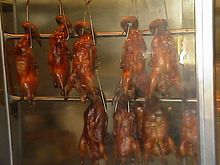 A display of Cantonese roast duck for sale in a delicatessen in Chinatown, Los Angeles
A display of Cantonese roast duck for sale in a delicatessen in Chinatown, Los Angeles
Also, Chinese barbecue deli restaurants, called siu laap (燒臘) and sometimes called a "noodle house" or mein ga (麵家), are generally low-key and serve less expensive fare such as wonton noodles (or wonton mein), chow fun (炒粉, stir-fry rice noodles), Yeung Chow fried rice (揚州炒飯), and rice porridge or congee, known as juk in Cantonese Chinese. They also tend to have displays of whole pre-cooked roasted ducks and suckling pigs hanging in their windows, a common feature in most Chinatowns worldwide. These delis also serve barbecue pork (叉燒, cha siu), chicken feet, and other Chinese-style items less welcome to the typical Western palate. Food is usually intended for take-out. Some of these Chinatown restaurants sometimes have the reputation of being "greasy spoons" and reputation for poor service.
Vietnamese immigrants, both ethnic Chinese and non-Chinese, have opened restaurants in many Chinatowns, serving Vietnamese pho beef noodle soups and Franco-Vietnamese sandwiches. Some immigrants have also started restaurants serving Teochew Chinese cuisine. Some Chinatowns old and new may also contain several pan-Asian restaurants offering a variety of Asian noodles under one roof.
Chifas
A special feature of Chinatown in Lima, Peru (Barrio Chino de Lima) is the chifa, a Chinese-Peruvian type of restaurant which mixes Cantonese Chinese cuisine with local Peruvian flavours. Chifa is the Peruvian Spanish deriative of the Cantonese phrase jee fon (饎飯), which renders as "cook rice" or as "cook meal'". This type of restaurant is popular with native Peruvians.
Shops
Most Chinatown businesses are engaged in the import-export and wholesale businesses; hence a large number of trading companies are found in Chinatowns.
Ginseng, herbs and animal parts
Small ginseng and herb shops are common in most Chinatowns, selling products used in traditional Chinese medicine. The Canadian government has stepped up policing of Chinese traditional medicinal stores and on a few occasions several Chinese stores in Vancouver and Toronto have been raided for products taken from the harvesting of rare and endangered species, such as tiger bone, bear paw and bear gall bladder.[citation needed] This has been alleged by some Chinese to be racial persecution, despite environmental and moral concerns.[citation needed] Other products sold in this trade include sea cucumbers, sea horses, lizards, deer musk glands, shark fins, swallows' nests, antlers, bear bile pills, crocodile bile pills, deer musk pills, rhino skin pills, and pangolin pills, as well as a wide range of mushrooms, herbs, bark, seaweed, roots, and similar items.
Markets
As with the restaurant trade, grocery stores and seafood markets serve a key function in Chinatown economies, and these stores sell Chinese ingredients to such restaurants. Such markets are wholesalers. Chinatown grocers and markets are often characterized by sidewalk vegetable and fruit stalls – a quintessential image of Chinatowns – and also sell a variety of grocery items imported from East Asia (chiefly Mainland China, Taiwan, Japan, and South Korea) and Southeast Asia (principally Vietnam, Thailand, and Malaysia). For example, most Chinatown markets stock items such as sacks of Thai jasmine rice, Chinese chrysanthemum and oolong teas, bottles of oyster sauce, rice vermicelli, Hong Kong soybean beverages, Malaysian snack items, Taiwanese rice crackers, and Japanese seaweed and Chinese specialties such as black duck eggs (often used in rice porridge), bok choy, and water chestnuts. These markets may also sell fish (especially tilapia) and other seafood items, which are kept alive in aquariums, for Chinese and other Asian cuisine dishes. Until recently, these items generally could not be found outside the Chinatown enclaves, although since the 1970s Asian supermarkets have proliferated in the suburbs of North America and Australia, competing strongly with the old Chinatown markets.
Religious and funerary supplies
In keeping with Buddhist and Taoist funeral traditions, Chinese specialty shops also sell incense and funeral items which provide material comfort in the afterlife of the deceased. Shops sell specially-crafted replicas of small paper houses, paper radios, paper televisions, paper telephones, paper jewelry, and other material items. They also sell "hell money" currency notes. These items are intended to be burned in a furnace.
These businesses also sell red, wooden Buddhist altars and small statues for worship. Per Chinese custom, an offering of oranges are usually placed in front of the statue in the altar. Some altars are stacked atop each other. These altars may be found in many Chinatown businesses.
Video CD stores
Chinatowns may contain small businesses that sell imported VCDs and DVDs of Chinese-language films and karaoke. The VCDs are mainly titles of Hong Kong and PRC films, while there are also VCDs of Japanese anime and occasionally pornography. Often, imported bootleg DVDs and VCDs are sold owing to lax enforcement of copyright laws.
Street merchants
Street merchants selling low-priced vegetables, fruits, clothes, newspapers, and knickknacks are common in most Chinatowns. Most of the peddlers tend to be elderly (Cantonese: lo wah cue).
Benevolent and business associations
Benevolent associations have been associated with the Kuomintang. The flag of the Republic of China is still flown by most benevolent associations in San Francisco Chinatown, including these on Waverly Street.
A major component of many Chinatowns is the family benevolent association, which provides some degree of aid to immigrants. These associations generally provide social support, religious services, death benefits (members' names in Chinese are generally enshrined on tablets and posted on walls), meals, and recreational activities for ethnic Chinese, especially for older Chinese migrants. Membership in these associations can be based on members sharing a common Chinese surname or belonging to a common clan, spoken Chinese dialect, specific village, region or country of origin, and so on. Many have their own facilities.
Some examples include San Francisco's prominent Chinese Consolidated Benevolent Association (中華總會館), aka Chinese Six Companies, and Los Angeles' Southern California Teochew Association. The Chinese Consolidated Benevolent Association is among the largest umbrella groups of benevolent associations in the North America, which branches in several Chinatowns. Politically, the CCBA has traditionally been aligned with the Kuomintang and the Republic of China.
The London Chinatown Chinese Association is active in Chinatown, London. Paris has an institution in the Association des Résidents en France d'origine indochinoise and it servicing overseas Chinese immigrants in Paris who were born in the former French Indochina.
Traditionally, Chinatown-based associations have also been aligned on ethnic Chinese business interests, such as restaurant, grocery, and laundry (antiquated) associations in Chinatowns in North America. In Chicago's Chinatown, the On Leong Merchants Association was active.
Annual events in Chinatown
 Moon festival lantern parade in Chinatown, Los Angeles, 1954
Moon festival lantern parade in Chinatown, Los Angeles, 1954
Most Chinatowns present Chinese New Year (also known as Lunar New Year) festivities with dragon and lion dances accompanied by the rhythm of clashing of cymbals, clanging on a gong, clapping of hardwood clappers, by pounding of drums, and by loud Chinese firecrackers, set off especially in front of ethnic Chinese storefronts, where the "lion" character attempts to reach for a lettuce or catch an orange. The lion typically contains two performers and performances may involves several stunts. In return, storekeepers usually donate some money to the performers, some of whom belong to local martial arts affiliations.
In addition, Chinatowns close off some streets for parades, Chinese acrobatics and martial-arts demonstrations, street festivals, and carnival rides—this is dependent on the promoters or organizers of the events. Other festivals may also be held in a parking lot/car park, local park, or school grounds within Chinatown.
Some Chinatowns hold an annual "Miss Chinatown" beauty pageant, such as "Miss Chinatown San Francisco," "Miss Chinatown Hawaii," "Miss Chinatown Houston" or "Miss Chinatown Atlanta."
Dragon and lion dances
 Like Chinese worldwide, the people in Calgary, Alberta's Chinatown perform dragon dances for good luck.
Like Chinese worldwide, the people in Calgary, Alberta's Chinatown perform dragon dances for good luck.
Dragon and lion dances are performed in Chinatown every Chinese New Year, particularly to scare off evil spirits and bring good fortune to the community. They are also performed to celebrate a grand opening of a new Chinatown business, such as a restaurant or bank.
Ironically, many lion and dragon dances are considered more preserved in true form in Chinatowns than in China itself. This discrepancy is attributed to the fact that traditional Chinese customs, including lion and dragon dances, were unable to flourish during the political and social instabilities of Imperial China under rule of the Qing Dynasty and were almost eliminated completely under the communist order of the People's Republic of China under Chairman Mao Zedong. However, due to the migration of Chinese all over the world (particularly Southeast Asia), the dances were continually practiced by overseas Chinese and performed in Chinatowns.
Ceremonial wreaths and leafy green plants with red-coloured ribbons strewn across are also usually placed in front of new Chinatown businesses by well-wishers (particularly family members, wholesalers, community organizations, and so on), to assure future success.
Names for Chinatowns
Although the term "Chinatown" was first used in Asia, it does not come from a Chinese language. Its earliest appearance seems to have been in connection with the Chinese quarter of Singapore which by 1844 was already being called "China Town" or "Chinatown" by the British colonial government. [19][20] This may have been a word-for-word translation into English of the Malay name for that quarter, which in those days was probably "Kampong China" or possibly "Kota China" or "Kampong Tionghua/Chunghwa/Zhonghua". As noted below, Singaporean Chinese themselves used other names.
The first appearance of a Chinatown outside Singapore may have been in 1852, in a book by the Rev. Hatfield, who applied the term to the Chinese part of the main settlement on the remote South Atlantic island of St. Helena. [21] The island was a regular way-station on the voyage to Europe and North America from Indian Ocean ports, including Singapore.
One of the earliest American usages dates to 1855, when San Francisco newspaper The Daily Alta California described a "pitched battle on the streets of [SF's] Chinatown." [22] Other Alta articles from the late 1850s make it clear that areas called "Chinatown" existed at that time in several other California cities, including Oroville and San Andres. [23][24] By 1869, "Chinatown| had acquired its full modern meaning all over the U.S. and Canada. For instance, an Ohio newspaper wrote: "From San Diego to Sitka..., every town and hamlet has its 'Chinatown'."[25]
In British publications before the 1890s, "Chinatown" appeared mainly in connection with California. At first, Australian and New Zealand journalists also regarded Chinatowns as Californian phenomena. However, they began using the term to denote local Chinese communities as early as 1861 in Australia[26] and 1873 in New Zealand.[27] In most other countries, the custom of calling local Chinese communities "Chinatowns" is not older than the twentieth century.
Several alternate English names for Chinatown include China Town (generally used in British and Australian English), The Chinese District, Chinese Quarter and China Alley (an antiquated term used primarily in several rural towns in the western United States for a Chinese community; some of these are now historical sites). In the case of Lillooet, British Columbia, Canada, China Alley was a parallel commercial street adjacent to the town's Main Street, enjoying a view over the river valley adjacent and also over the main residential part of Chinatown, which was largely of adobe construction. All traces of Chinatown and China Alley there have disappeared, despite a once large and prosperous community.
In other languages
In Chinese, Chinatown is usually called "唐人街", in Cantonese Tong yan gai, in Mandarin Tángrénjiē, in Hakka Tong ngin gai, and in Toisan Hong ngin gai, literally meaning "Tang people's street(s)". The Tang Dynasty was a zenith of the Chinese civilization, after which some Chinese—especially in the South—call themselves. Some Chinatowns are indeed just one single street, such as the relatively short Fisgard Street in Victoria, British Columbia, Canada or the sprawling 4-mile (6.4 km) new Chinatown in Houston, Texas. However, most Chinatown are in fact multiple intersecting streets.
A more modern Chinese name is 華埠 (Cantonese: Waa Fau, Mandarin: Huábù) meaning "Chinese City", used in the semi-official Chinese translations of some cities' documents and signs. Bù, pronounced sometimes in Mandarin as fù, usually means seaport; but in this sense, it means city or town. Likewise, Tong yan fau (唐人埠 "Tang people's town") is also used in Cantonese nowadays. The literal word-for-word translation of Chinatown—Zhōngguó Chéng (中國城) is also used, but more frequently by visiting Chinese nationals rather than immigrants of Chinese descent who live in the Chinatowns.
In Francophone regions (such as France and Quebec), Chinatown is often referred to as le quartier chinois (the Chinese Quarter; plural: les quartiers chinois) and the Spanish-language term is usually el barrio chino (the Chinese neighborhood; plural: los barrios chinos), used in Spain and Latin America. (However, barrio chino or its Catalan cognate barri xines do not always refer to a Chinese neighborhood: these are also common terms for a disreputable district with drugs and prostitution, and often no connection to the Chinese.). The Vietnamese term for Chinatown is Khu người Hoa, due to the prevalence of the Vietnamese language in Chinatowns of Paris, Los Angeles, Toronto, and Montreal as ethic Chinese from Vietnam have set up shop in them. Other countries also have idiosyncratic names for Chinatown in local languages and in Chinese; however, some local terms may not necessarily translate as Chinatown. For example, Singapore's tourist-centric Chinatown is called in local Singaporean Mandarin Niúchēshǔi (牛车水), which literally means "Ox-cart water" from the Malay 'Kreta Ayer' in reference to the water carts that used to ply the area. Some languages have adopted the English-language term, such as Dutch, German, and Bahasa Malaysia. In Malaysia, the term Chinatown is named under administrative reason. Instead, the name Chee Chong Kai (茨厂街)is preferred and agreed upon by the locals. Chee in Hakka means tapioca, chong means factory and kai means street. This is originated from a factory that was set up by Yap Ah Loy, a rich Kapitan (a Chinese immigrant who had administrative and political power under the British rule) that made tapioca. Chee Chong Kai is also called jalan Petaling or "Petaling Street".
See also
- Big Trouble in Little China
- Chinatown bus lines
- Europe Street, a street in China dedicated to European culture
- Jack Manion San Francisco's Chinatown squad
- Japantown
- Koreatown
- List of named ethnic enclaves in North American cities
- List of U.S. cities with significant Chinese American populations
- Little India (location)
- Little Pakistan
- Little Saigon
- Little Taipei
- Thai Town, Los Angeles
References
- ^ Raitisoja, Geni " Chinatown Manila: Oldest in the world", Tradio86.com, July 8, 2006, accessed March 19, 2011.
- ^ Takekoshi, Yosaburō (2004). economic aspects of the history of the civilization of Japan, Vol. 2. London: Routledge. pp. 124.
- ^ Li, Qingxin (2006). Maritime Silk Road. China International Press. pp. 157.
- ^ Abeyesekere, Susan (1987). Jakarta: A History. Oxford University Press. pp. 6.
- ^ "The History of Chinatown Bangkok". Yaowarat Heritage Centre. http://www.tour-bangkok-legacies.com/yaowarat-heritage-centre.html. Retrieved 2 October 2011.
- ^ a b c Bacon, Daniel: Walking the Barbary Coast Trail 2nd ed., page 50, Quicksilver Press, 1997
- ^ a b c Richards, Rand: Historic San Francisco, 2nd Ed., page 198, Heritage House Publishers, 2007
- ^ a b c Morris, Charles: San Francisco Calamity by Earthquake and Fire, pgs. 151-152, University of Illinois Press, 2002
- ^ "USA". Chinatownology.com. http://www.chinatownology.com/usa.html. Retrieved 2011-09-11.
- ^ "Chinatown San Francisco Pictures and History". Inetours.com. 2007-03-11. http://www.inetours.com/Pages/SFNbrhds/Chinatown.html. Retrieved 2011-09-11.
- ^ "New York-Newark-Bridgeport, NY-NJ-CT-PA Combined Statistical Area". American Community Survey. U.S. Census Bureau. 2009. http://factfinder.census.gov/servlet/ADPTable?_bm=y&-context=adp&-qr_name=ACS_2009_1YR_G00_DP5&-ds_name=ACS_2009_1YR_G00_&-tree_id=309&-redoLog=false&-_caller=geoselect&-geo_id=33000US408&-format=&-_lang=en. Retrieved 2010-10-01
- ^ Kirk Semple (2011-06-23). "Asian New Yorkers Seek Power to Match Numbers". The New York Times Company. http://www.nytimes.com/2011/06/24/nyregion/asian-new-yorkers-asian-new-yorkers-seek-power-to-match-surging-numbers.html?scp=1&sq=asians&st=cse. Retrieved 2011-06-24.
- ^ a b c d Waxman, Sarah. "The History of New York's Chinatown". ny.com. http://www.ny.com/articles/chinatown.html. Retrieved 2009-05-04.
- ^ Semple, Kirk (2009-10-21). "In Chinatown, Sound of the Future Is Mandarin". The New York Times. http://www.nytimes.com/2009/10/22/nyregion/22chinese.html. Retrieved 2011-06-29.
- ^ "Chinatown Vancouver Online". Vancouverchinatown.ca. http://vancouverchinatown.ca/. Retrieved 2011-09-11.
- ^ "China Town Antwerpen". Chinatown-antwerpen.be. http://www.chinatown-antwerpen.be. Retrieved 2011-09-11.
- ^ "What happened to cardiff china town? - Discussion Board". Britishchineseonline.com. 2005-10-05. http://www.britishchineseonline.com/forum/showthread.php?t=28439. Retrieved 2011-09-11.
- ^ "Liverpool and it's Chinese Children". Halfandhalf.org.uk. http://www.halfandhalf.org.uk. Retrieved 2011-09-11.
- ^ Simmond's Colonial Magazine and Foreign Miscellany: 35. Jan-Apr 1844.
- ^ Sydney Morning Herald. 1844-07-23, p 2.
- ^ Hatfield, Edwin F. (1852). St. Helena and the Cape of Good Hope. p. 197.
- ^ Alta California. 1855-12-12, p 1.
- ^ Alta California. 1857-12-12, p 1.
- ^ Alta California. 1858-06-04, p 2.
- ^ Defiance Democrat. 1869-06-12, p 5.
- ^ Ballarat Star. 1861-02-16, p 2.
- ^ Tuapeka Times. 1873-02-06, p 4.
Further reading
- Chew, James R. "Boyhood Days in Winnemucca, 1901–1910." Nevada Historical Society Quarterly 1998 41(3): 206–209. ISSN 0047-9462 Oral history (1981) describes the Chinatown of Winnemucca, Nevada, during 1901–10. Though many Chinese left Winnemucca after the Central Pacific Railroad was completed in 1869, around four hundred Chinese had formed a community in the town by the 1890s. Among the prominent buildings was the Joss House, a place of worship and celebration that was visited by Chinese president Sun Yat-Sen in 1911. Beyond describing the physical layout of the Chinatown, the author recalls some of the commercial and gambling activities in the community.
- "Chinatown: Conflicting Images, Contested Terrain", K. Scott Wong, Melus (Vol. 20, Issue 1), 1995. Scholarly work discussing the negative perceptions and imagery of old Chinatowns.
- Pan, Lynn. Sons of the Ugly Yellow Emperor: A History of the Chinese Diaspora (1994). Book with detailed histories of Chinese diaspora communities (Chinatowns) from San Francisco, Honolulu, Bangkok, Manila, Johannesburg, Sydney, London, Lima, etc.
- Williams, Daniel. "Chinatown Is a Hard Sell in Italy", Washington Post Foreign Service, March 1, 2004; Page A11.
External links
- Chinatown Paris France
- India's only ChinaTown
- Chinatowns of the World – slideshow by Life magazine
- Chinatown San Francisco
- Historical Photos of American Chinatowns
- Chinatownology: Singapore Chinatown
- Chinese New Year Parade and Festivals
- A Journey through Chinatown New York City's 3 Chinatowns.
- A short film about New York City's Chinatown, 5 lessons and 9 questions about Chinatown
- The Museum of Chinese in America
- Yamashita's Web Site—Pictures of Chinatowns
- Asian-Nation: Ethnic Enclaves & Communities
- Boston's Chinatown
- Chinatown Belarus
Ethnic enclaves Actual Little Arabia · Cambodia Town · Chinatown · Greektown · Little Italy · Little India · Japantown · Koreatown · Little Manila · Little Pakistan · Russiatown · Little Saigon · Little Taipei · Thaitown
Artificial Chinatowns Africa South Africa: JohannesburgAsia India: Kolkata · Makum (closed) · Mumbai (closed), Indonesia: Jakarta, Iran: Mahale Chiniha, Japan: Kobe · Nagasaki · Yokohama, Malaysia: Kuala Lumpur, Myanmar: Yangon, Pakistan: Karachi, Philippines: Manila, Singapore Singapore, South Korea: Incheon, Thailand: Bangkok, United Arab Emirates: Dubai, Vietnam: Ho Chi Minh City (Saigon)Europe Latin America Argentina: Buenos Aires, Brazil: São Paulo, Costa Rica: San José, Cuba: Havana, Mexico: Mexicali · Mexico City, Peru: LimaNorth America Canada: Calgary · Edmonton · Lethbridge · Montreal · Ottawa · Toronto · Vancouver · Victoria · Winnipeg
United States: Boston · Brooklyn · Chicago · Cleveland · Flushing · Honolulu · Houston · Las Vegas · Los Angeles · Newark · New York · Oakland · Oklahoma City · Philadelphia · Portland · San Francisco · Seattle · Washington D.C.Oceania Categories:- Chinatowns
- Chinese diaspora
- Ethnic enclaves
Wikimedia Foundation. 2010.

